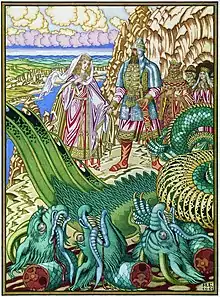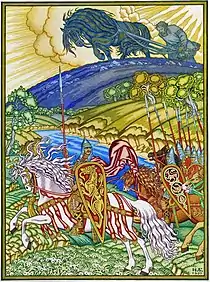Bylina
A bylina (Russian: были́на, IPA: [bɨˈlʲinə]; pl. были́ны byliny) is a traditional Russian oral epic poem.[1] Byliny songs are loosely based on historical fact, but greatly embellished with fantasy or hyperbole to create their songs.[2] The word bylina is derived from the past tense of the verb "to be" (Russian: был, tr. byl) and implies "something that was."[3] The term most likely originated with scholars of Russian folklore; in 1839, Ivan Sakharov, a Russian folklorist, published an anthology of Russian folklore, a section of which he titled "Byliny of the Russian People", causing the popularization of the term.[4][5] Later scholars believe that Sakharov misunderstood the word bylina in the opening of Igor' Tale as "an ancient poem." The folk singers of byliny called these songs stariny (Russian: ста́рины, IPA: [ˈstarʲɪnɨ]; sg. ста́рина starina) or starinki (Russian: старинки), meaning "stories of old" (Russian: старый, tr. staryj).[2]

History
Most historians of East Slavic and Russian folklore believe that byliny as a genre arose during the Kievan Rus', during the tenth and eleventh century. Byliny continued to be composed till around the arrival of the Tatars in the thirteenth century and the destruction of the Old East Slavic civilization.[6] Byliny incorporate elements of history from several epochs into their stories. For example, byliny singers refer to many of the enemies of the Kievan people as Tartars although the stories originally referred to other steppe peoples in conflict with Kievan Rus'. The character of Prince Vladimir refers to a generalized "epic Vladimir" rather than an allusion to a specific historical Vladimir.[7]
Anthologists played an important role in the narration and preservation of byliny. After Sakharov, there were numerous other anthologists who contributed to its development, particularly during the eighteenth century. For example, Kirsha Danilov produced a compilation of seventy byliny. His sources were believed to be miners living in the Perm area. The works of these folklorists provided insights into the transition of the Russian literary tradition from one that was focused on religious subjects to secular literature. The first transcriptions of byliny are attributed to Richard James, an Englishman who traveled to Russia from 1617 to 1619.[8] The texts that he was able to record are now preserved in the Bodleian Library at Oxford.
There was also a known German translation of the byliny and this was published anonymously in 1819.[9] Overall, interest in these epic poems continued to the point that comprehensive and wide-ranging materials were sourced from virtually all of Great Russia. Although these were preserved, according to Kahn et al., only those byliny from "northern Russia, the areas of Arkhangelsk, Olonetsk, the Onega region, and parts of Siberia" were actively preserved into the twentieth century.[10]
Collections
Byliny have been collected in Russia since the seventeenth century; initially they were published for entertainment in prose paraphrases. The Cossack Kirsha Danilov compiled the most notable of the early collections in the Ural region for the mill owner Prokofi Demidov in the middle of the eighteenth century.[11] In the middle of the nineteenth century Pavel Rybnikov traveled through the region of Lake Onega and rediscovered that the bylina tradition, which was thought to be extinct, still flourished among the peasants of northeast Russia. A storm stranded Rybnikov on an island in Lake Onega where he heard the sound of a bylina being sung; he persuaded the singer to repeat the song and wrote down his words. He proceeded to collect several hundred bylina, all of which he recorded from spoken paraphrase, and published them from 1861 to 1867 in several volumes entitled Songs Collected by P. N. Rybnikov.[12]
Another influential collector, Alexander Gilferding, published one collection entitled Onega Bylinas Recorded by A. F. Gilferding in the Summer of 1871. He improved upon Rybnikov's work by transcribing the byliny directly from the sung performance rather than the spoken retellings. He noticed that the rhythm differed between the sung and spoken versions, and asked the performers to pause for a longer period of time between lines to allow him time to record the words from the song itself. He also organized his collection by singer rather than subject and included short biographical sketches of the performers with their collected songs, thus focusing on the singer's role in the composition of the song.[13] Following the work of Rybnikov and Gilferding, many more scholars searched for byliny everywhere in northern Russia, and obtained byliny from the shores of the White Sea and the rivers flowing to the north.[14]
Classifications
There are several ways to categorize bylina, and scholars disagree on which classification to use. Scholars from the mythological school differentiate between byliny about 'older' and 'younger' heroes. The 'older' heroes resembled mythological figures, while the 'younger' heroes resembled ordinary human beings. The historical school classifies byliny based on the principality in which the story took place, as in Kievan, Novgorodian, and Galician-Volhynian cycles. The mythological byliny of giants and the like probably originated long before the Kievan state was founded, and cannot be classified easily by principality. Scholars of the historical school often consider mythological byliny separately. Other scholars group byliny based on content, including heroic, fairy tale type, novella type and ballad-byliny. Most scholars prefer classification based on principalities.[15]
Structure
Because of their nature as performed pieces, byliny singers employ basically linear and easy to follow structure.[16] Byliny structure typically includes three basic parts, introduction, narrative portion and epilogue. The introduction sometimes includes a verse to entice the audience to listen. Introductions often describe heroes at a feast being given a task or setting out on a mission. The narrative portion relates the adventure with exaggerated details and hyperbole to make the story more exciting. The epilogue refers to the reward for the mission, a moral or a reference to the sea, since byliny were often performed to attempt to calm the sea.[17] To help listeners grasp the story, singers used 'tag lines' to preface speeches or dialogues, setting up for the audience who is talking to whom.[16]
Common themes
Scenes common to byliny include a hero taking leave of his mother, saddling a horse, entering a council chamber, bragging, departing over the wall of a city, going on a journey, urging on his horse, in battle, dressing in the morning, exchanging taunts with an enemy, becoming blood brothers with another hero, and asking for mercy. Singers may use their telling of these scenes in many of their songs, incorporating different elements in song after song. Themes in many bylina include the birth and childhood of a hero, father and son fighting, battling a monster, the imprisoned or reluctant hero returning in time to save his city, matchmaking or bride taking, a husband arriving at the wedding of his wife and encounters with a sorceress who turns men into animals.[18] Christian beliefs mixed with pre-Christian ideas of magic and paganism in byliny, for instance, saints would appear to defend mortals against darkness.[19]
Major characters and prototypes

| Russian name | English name | Prototype |
|---|---|---|
| Илья Муромец | Ilya Muromets | Saint Ilya Pechorsky, monk of Kiev Pechersk Lavra |
| Добрыня Никитич | Dobrynya Nikitich | Dobrynya, Kievan voivode. |
| Алёша Попович | Alyosha Popovich | Rostov boyar Alexander (Olesha) Popovich. |
| Святогор | Svyatogor | East Slavic pre-Christian folk tales. |
| Микула Селянинович | Mikula Selyaninovich | Personification of the Russian peasants. |
| Князь Владимир | Prince Vladimir | Vladimir the Great |
| Вольга Святославич | Volga Svyatoslavich | Prince Oleg |
| Евпатий Коловрат | Eupaty Kolovrat | Ryazan nobleman with the same name. |
| Садко | Sadko | |
| Никита-кожемяка | Nikita the Tanner | |
| Василий Буслаев | Vasily Buslayev | |
| Дюк Степанович | Duke Stepanovich | |
| Змей Горыныч | Zmey Gorynych | Slavic variation of the European dragon. |
| Солове́й-Разбо́йник | Nightingale the Robber |
Adaptations
Vasily Kalinnikov, a famous Russian composer from the nineteenth century composed an overture on this theme, Bylina. The music of the State Anthem of the Soviet Union and the Russian national anthem is also said to be inspired by the bylina tradition.
References
- Bylina (Russian Poetry). Encyclopædia Britannica. Retrieved 5 December 2010.
- Oinas, Felix J. (1978). "Russian Byliny". Heroic Epic and Saga: an Introduction to the World's Great Folk Epics. Bloomington: Indiana University Press. p. 236.CS1 maint: ref=harv (link)
- Bailey, James; Ivanova, Tatyana (1998). An Anthology of Russian Folk Epics. Armonk, NY: M. E. Sharpe. p. xx.CS1 maint: ref=harv (link)
- Alexander, Alex E. (1973). Bylina and Fairy Tale; the Origins of Russian Heroic Poetry. The Hague: Mouton. p. 13.
- Alexander, Alex E. (September 1975). Jack V. Haney (reviewer). "Bylina and Fairy Tale: The Origins of Russian Heroic Poetry". Slavic Review. Association for Slavic, East European, and Eurasian Studies. 34 (3): 648–649. doi:10.2307/2495628. JSTOR 2495628.
- Oinas (1978), p. 238.
- Bailey & Ivanova (1998), p. xx.
- Chadwick, H. Munro; Chadwick, Nora (1986). The Growth of Literature. Cambridge: Cambridge University Press. p. 134. ISBN 0-521-31017-2.
- Chadwick & Chadwick, p. 134.
- Kahn, Andrew; Lipovetsky, Mark; Reyfman, Irina; Sandler, Stephanie (2018). A History of Russian Literature. Oxford: Oxford University Press. p. 48. ISBN 978-0-19-966394-1.
- Oinas (1978), pp. 236-237.
- Bailey & Ivanova (1998), pp. xv-xvi.
- Bailey & Ivanova (1998), pp. xvi-xvii.
- Oinas (1978), p. 237.
- Oinas (1978), p. 240.
- Bailey & Ivanova (1998), pp. xxvi-xxvii.
- Oinas (1978), pp. 247-249.
- Bailey & Ivanova (1998), pp. xxvii-xxviii.
- Elizabeth Warner, Russian Myths (Austin: University of Texas Press, 2002), 18-20.